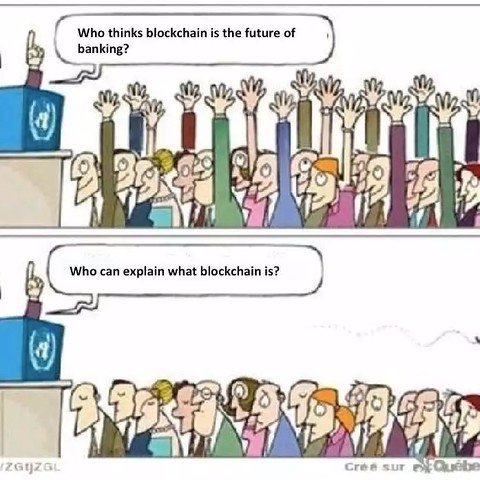How to Explain Blockchain So Newbies Really Get It

How do you explain blockchains and decentralization to someone so that their eyes don't glaze over? How can you get someone to actually understand blockchain technology, and why it matters? How can you help your friends understand what this "complicated overhyped techie gibberish" you're so excited about is?
As a writer, this is a question I've wrestled with. Especially when covering it in the mainstream media.
This is where I'm at now with a general-public, accessible-to-anyone explanation of the history, the technology, and the significance. Had a little help from James Glasscock at DNA (thanks James - you need to bring your brain over to Steemit).
(Note that this is the full version. Often, for a quick explanation, I'll just use the two paragraphs that specifically explain blockchain.)
If you like it, feel free to take it and use it or parts of it. It's yours.
The other reason I'm posting this is that I'd love your feedback. You have corrections or notes, please let me know in the comments so that I can continue to refine - with the goal of further simplifying, clarifying, and accuracy:
I'm sure many of you have your own newbie explanation for this. I'd love to read it below as well. In fact, it would be kind of cool to make a documentary (or Dtube video) of different thought and industry leaders giving their own version of a blockchain explanation.
WHAT IS BLOCKCHAIN
There’s a revolution brewing that has the potential to advance the Internet era from adolescence to maturity, and in the process, alter nearly every major industry and government.
The engine behind this change is blockchain—or, more broadly, distributed ledger technology. Some futurists are already calling this the fourth industrial revolution (as significant as the steam engine, electricity, and the microchip before it).
But what is blockchain?
Knowing how the blockchain works is about as elucidating as explaining TCP/IP protocols to someone who’s never used the Internet—or even someone who has. A better way to understand it is to learn its history, which some advocates liken to immaculate conception.
In 2008, a person (or more likely, group of people) using the pseudonym Satoshi Nakamoto began contributing out of the blue to a cryptography mailing list. “I’ve been working on a new electronic cash system that’s fully peer-to-peer, with no trusted third party,” Nakamoto wrote.
The digital currency he was developing, called Bitcoin, offered a way to make direct payments over the Internet anonymously. And it was independent of not just intermediaries like banks and credit card companies, but also governments and their monetary policies.
The programming challenge, though, was how to make sure no single entity controlled Bitcoin, users couldn’t double-spend the same coin, and hackers couldn’t infiltrate the system. The solution was to not trust people, but to trust an open network of independent computers around the world instead. And so Nakamoto started a peer-to-peer network, where transactions had to be verified on multiple computers (or nodes) before being approved. This is known as consensus.
These transactions are organized into blocks of data that are complexly encrypted and permanently linked together in chronological order. Each block contains a snapshot of all the blocks that have come before it, and this growing chain is then stored on the entire network, making it likely impossible to alter anything without getting caught. Think of it as the computer equivalent of DNA.
This is the blockchain: a public database of cryptographically secured permanent records stored on thousands of computers, which prevents them from being controlled, manipulated, or vulnerable to a single point of failure (or a single point of trust). And so far, it’s worked: Bitcoin has never been hacked.
Thus, in this plan for Bitcoin, which Nakamoto launched a year later, were the seeds of not just a currency but a movement: it was accessible, replicable, secure, anonymous, decentralized, transparent, and consensus-driven. It is poised to change nearly everything that requires a record being kept of it, whether real estate, banking, stocks, marriages, contracts, or personal identification -- as well as most types of if/then agreements (called a smart contract when on a blockchain) . But beyond this, advocates believe this technology can help solve not just online problems like privacy, cybersecurity and the concentration of power into the hands of half a dozen big tech companies, but global problems like poverty, corruption and financial exclusion.
“Just as we progressed in the past to expect a separation of church and state, we are now moving towards the possibility of a separation of bank and state.,” explains Galia Benartzi, co-founder of Bancor. “Money, how we make it and use it, may return to the domain of the people and the discretion of the individual, just like religion once did."
Brock Pierce, chairman of the Bitcoin Foundation, describes it thusly: “When the Internet was first being developed in the ‘70s and ‘80s, we didn’t have the computer processing capability to actually secure the Internet. By the time we got the processing ability to implement the necessary cryptography to secure it, the foundation had already been laid. So we just kept building for, like, 30 years. But it's been fundamentally broken the whole time. The blockchain brings the most secure system the world's ever seen, immutability in terms of recordkeeping, and the ability to be transparent. And with this new technology, we can do ten times more than we could ever do with the Internet.”
Most people want the world to become safer, more free, more open, and more equal—and would prefer anonymity to be a choice rather than a Sisyphean struggle. The blockchain is arguably the best and quickest way to build this world. That’s why decentralized blockchain not only matters, but your understanding of it and advocacy for the future you'd like to see is essential.
Pass it on.
Posted using Partiko Android